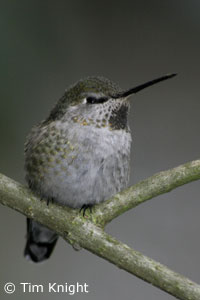

|
The Anna's Hummingbird (Calypte anna) was named after the 19th century Italian duchess Anna De Belle Massena.
Hummingbirds are part of the Trochilidae family found only in the Americas. They are unknown in the Eastern Hemisphere. With 343 species, hummingbirds make up the Western Hemisphere's second largest family of birds. Range / Habitat: Originally found only on the Pacific slope from Baja California to San Francisco, Anna's Hummingbird has increased its population and expanded its breeding range in recent years to Vancouver, British Columbia, east to southern Arizona. (Cornell Laboratory of Ornithology) There are four species of hummingbirds found in the Pacific Northwest: Anna's, Black-chinned, Calliope, and Rufous. Of these four species, only Anna's Hummingbird can be found year round the Puget Sound region of western Washington. The other three species of hummingbirds arrive in early spring, when native plants begin to bloom, and usually depart by October to migrate to Mexico or the Southern United States. 
The increasing popularity of hummingbird feeders and of urban plantings that provide flowers in blossom year-round are the major reasons for the range expansion of Anna’s Hummingbird northward into Washington. Click the range map to learn more about the distribution of Anna's Hummingbirds in Washington. Diet: Anna's Hummingbirds feed on nectar from flowers and feeders, as well as small insects and spiders. This hummingbird consumes more insects than any of the other North American hummingbirds, catching small flying insects on the wing. Plucks spiders and trapped insects from spider webs. They also visit sapsucker holes and feed on sap and insects attracted to the holes. (Seattle Audubon Society) Hummingbirds feed about 5-10 times per hour for 30-60 seconds each time. Hummingbirds feed through a long, tube-like tongue that darts into the flower's corolla for nectar. The tongue, shaped like a "W", uses capillary action to absorb the nectar much like a paper towel absorbs water. Behavior: A hummingbird can rotate each of its wings in a circle, allowing them to be the only bird that can fly forwards, backwards, up, down, sideways or sit in sheer space. To hover, hummingbirds move their wings forward and backward in a repeated figure eight, similar to the arm movement of a swimmer treading water. Hummingbirds can move instantaneously in any direction, start from its perch at full speed, and doesn't necessarily slow up to land. Hummingbirds can even fly short distances upside down, a trick rollover they employ when being attacked by another bird. (source: humming-birds.com) Nesting: As is the case with other hummingbird species, male and female Anna's Hummingbirds associate only long enough to mate. The female is responsible for construction of the nest and care of the young. The breeding season begins in December and usually lasts until May or June. Females will lay a clutch of only two white eggs and will produce only one brood per season. The hummingbird eggs are roughly the size and shape of a small jellybean. The hatchlings will remain in the nest for three weeks.
Did you know?
More information: BirdWeb: Anna's Hummingbird All About Birds: Anna's Hummingbird Animal silhouettes available to purchase » Home | About Us | How to Participate | Biodiversity Modules | Projects | Maps | News | Resources |